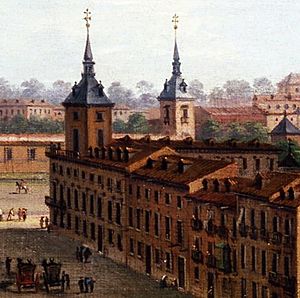Palacio del Marqués de Alcañices facts for kids
The Palacio del Marqués de Alcañices, also known as Palacio de Alcañices, was a grand building in Madrid, Spain. It no longer exists today. This palace was located on Calle de Alcalá, a famous street in the city. It also had another side facing the Paseo del Prado.
The palace got its name from its owners, the Marquesses of Alcañices. The last owner was José Osorio y Silva. He was a very important person who helped King Alfonso XIII when he was young. People knew him as Pepe Osorio or the Grand Duke of Sesto.
The palace was sold in 1882. This happened because the city needed to make the streets wider. Today, part of the land where the palace once stood is now home to the large building of the Bank of Spain.
Contents
A Look Back: The Palace's Story
The first records of the Palacio de Alcañices show it was built in the 1600s. It was built by Luis Méndez de Haro. He was a powerful nobleman and a close advisor to King Philip IV.
Later, around 1790, a noble family called the Dukes of Béjar lived there for a short time. However, they preferred their other large homes.
At the end of the 1700s, Manuel Miguel Osorio y Spinola bought the palace. He was the 15th Marquess of Alcañices. The palace and its gardens became a popular resting place for noble families. This was especially true because the Buen Retiro Palace was built almost directly across from it. Important people wanted to live close to the king's palace.
Changes Over Time
The palace started to show its age in the early 1800s. So, the Marquess of Alcañices had some improvements done. Many famous people visited the palace during this time.
The gardens of the palace also changed over the years. They were updated to match the popular styles of the time. For example, by 1875, the gardens looked like an English landscape garden. This was very different from the earlier, more formal designs.
In 1823, Manuel Miguel Osorio y Spinola passed away. His son, Nicolás Osorio y Zayas, inherited the palace. Nicolás was a big fan of horses. He even helped start a group to promote horse breeding in Spain. In 1854, he built new stables at the palace for his horses.
The Duke of Sesto's Era
Nicolás Osorio y Zayas died in 1866. His son, José Osorio y Silva, became the new owner. He was known as the Duke of Sesto. In 1872, José Osorio y Silva ordered a big renovation of the palace. He hired a famous architect named Francisco de Cubas y González-Montes.
This renovation happened after the Duke married Princess Sofia Sergeyevna Trubetskaya. Their marriage and political activities made the palace very important. It became a central meeting place for those who supported the return of King Alfonso XIII to the throne. During this time, the palace was at its most elegant and lively.
The Palace's End
Supporting the monarchy was very expensive for the Duke of Sesto. Also, the city needed to expand some old streets. These reasons forced the Duke to sell the palace in 1882. He sold it to the board of the Bank of Spain.
The palace was then torn down. In 1884, construction began on the huge headquarters building for the Bank of Spain. This new building took up not only the palace's land but also some neighboring properties. The sale of the palace helped the city expand the streets, and the Bank of Spain paid a large sum for the land.
Gallery
See also
 In Spanish: Palacio de Alcañices para niños
In Spanish: Palacio de Alcañices para niños






